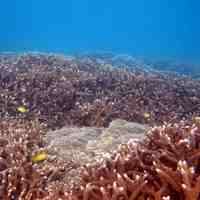Great Barrier Reef coral cores reveal 2011 flood damage

(Phys.org) —Scientists have gained new insight into the damage done to coral in the Southern Great Barrier Reef by river run-off caused by intense weather events like the 2011 floods.
Core samples obtained from corals around the Keppel Islands reveals the way flood plumes from Queensland's Fitzroy River catchment have impacted reefs as far as 50km from the mouth of the river.
Scientists, including Assistant Professor Jens Zinke of The University of Western Australia's Oceans Institute and School of Earth and Environment, sought to study how extreme rainfall and flood events around the Fitzroy River are controlled by the interplay between short and long-term climate cycles in the Pacific Ocean - and how that, in turn, affected coral health.
To do this, they examined metre-long coral cores for the tell-tale luminescence triggered by the kinds of organic compounds found in river plumes with their source in the hinterland and agricultural areas.
"When the water gets really turbid the corals take up all the parts that are in the water," Assistant Professor Zinke said. "Some of that is organic stuff which glows under UV light, and this is what we see in the coral. We can quantify the intensity of the glow, and that tells us when there was a large flood peak like in 2011."
It is the first time the 2011 event has been captured in coral cores - regarded by scientists as archives of climate change. The samples also revealed other events including big floods in the 1950s and 1970s.
Assistant Professor Zinke said the corals of the Great Barrier Reef - many of which could grow up to 5-6m over 400 years - provided longer term climate records than those available from satellite-based data, which went back only 20-30 years. The core samples used in the study provided information going back almost 100 years.
He said the very clear flood plume signature found in corals so far out, and over a long period of time, showed that the Southern Great Barrier Reef was particularly sensitive to climate extremes produced by the interplay between the long-term Pacific Decadal Oscillation cycle and shorter term La Niña events.
While these natural hazards associated with climatic phenomena were not new, warming ocean temperatures would continue to intensify the impact of such events. This in turn would mean more growth-inhibiting sedimentation reaching coral reefs.
"Any natural climate event that's happening now might be of a much larger magnitude because of ongoing ocean climate change," Assistant Professor Zinke said"The inshore reefs of the Great Barrier Reef are the most impacted, and management of the hinterland is probably the only action that can buy time for corals that are already stressed from these river flood plumes."
More information: Rodriguez-Ramirez A, Grove CA, Zinke J, Pandolfi JM, Zhao J-x (2014) "Coral Luminescence Identifies the Pacific Decadal Oscillation as a Primary Driver of River Runoff Variability Impacting the Southern Great Barrier Reef." PLoS ONE 9(1): e84305. DOI: 10.1371/journal.pone.0084305
Journal information: PLoS ONE
Provided by University of Western Australia



















